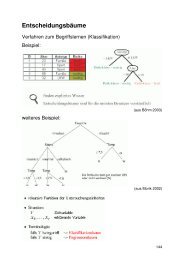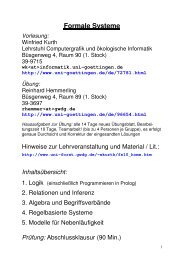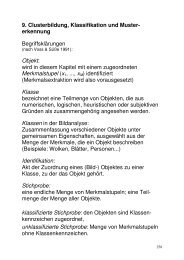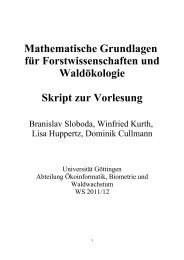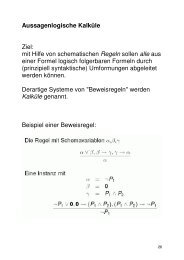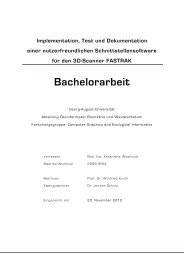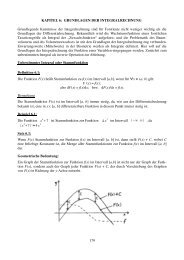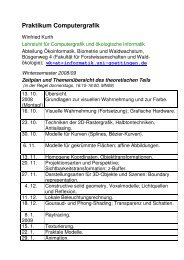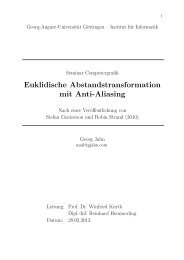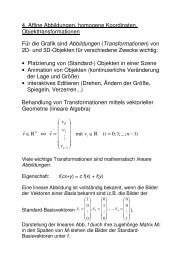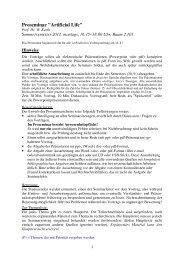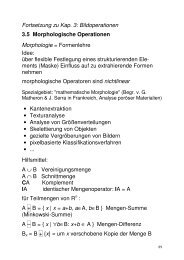Summer School Modelling and Simulation with GroIMP
Summer School Modelling and Simulation with GroIMP
Summer School Modelling and Simulation with GroIMP
Create successful ePaper yourself
Turn your PDF publications into a flip-book with our unique Google optimized e-Paper software.
Patrick Favre (University of Fribourg):<br />
A model of resource allocation in plant growth<br />
Our study is to underst<strong>and</strong> the adaptiveness of allocations resources for rosette plant growth.<br />
A mathematical model containing the shoot <strong>and</strong> the root compartments, was developed to<br />
integrate the physical <strong>and</strong> physiological properties for the production of sugar by the leaves,<br />
the uptake of phosphate by the roots <strong>and</strong> the transport of these substances to each<br />
compartment. Our equations were then incorporated in a Lindenmayer-systems model <strong>with</strong><br />
multiple-compartments using the Java-based <strong>GroIMP</strong> software. The 3D structure allows to<br />
calculate light interception, to take into account the root ramification <strong>and</strong> to make contact <strong>with</strong><br />
arbuscular mycorrhizae in the case of Petunia hybrida plants in symbiotic associations. This<br />
model will also be used to study growth of Arabidopsis thaliana mutants.<br />
Michael Henke (University of Göttingen):<br />
A first step towards a generic FSPM<br />
Paul Masters <strong>and</strong> Klaus-Peter Zauner (University of Southampton, UK):<br />
Robotropism: Distributed Control of Plants<br />
We envisage electronic controllers attached to plants to cause them to grow in desired<br />
directions. Rather like robots <strong>with</strong> plants as their bodies, the controllers may communicate<br />
<strong>and</strong> cooperate to encourage plants to grow along dynamically adjusted trajectories into predefined<br />
complex structures. Light, gravity <strong>and</strong> touch sensitivity are included into a model of a<br />
climbing plant. A physics engine is introduced to <strong>GroIMP</strong> as a way of modelling gravitational<br />
effects on the plants. The possibilities for growing simple structures are explored.<br />
Katarína Smoleňová <strong>and</strong> Gerhard Buck-Sorlin (University of Göttingen / Wageningen UR):<br />
An FSPM of barley including the allocation <strong>and</strong> effects of carbon, nitrogen <strong>and</strong><br />
gibberellic acid<br />
Raymond van Daelen (Keygene NV, Dept. Bio-Informatics, Wageningen):<br />
A tomato model<br />
The architecture of tomato is a crucial aspect for the production of tomatoes, for instance<br />
time <strong>and</strong> placing of inflorescences, structure of trusses, number of leaves between trusses,<br />
formation of side shoots, etc. Keygene is interested in analyzing mechanisms involved in<br />
determining these aspects. Even though many genes are known, such as SFT, SP, AN, BL,<br />
FA, S, J, F, which somehow affect flowering <strong>and</strong>/or truss shapes, the interactions between<br />
these genes, if any, is poorly known. We are developing a functional-structural plant model to<br />
analyze <strong>and</strong> possibly elucidate the potential interactions between these genes, to explain the<br />
mechanisms that determine the meristem fate <strong>with</strong> respect to vegetative growth <strong>and</strong> switch<br />
to flowering. We will present the current state of the developed model, which was created<br />
using <strong>GroIMP</strong>.<br />
4



